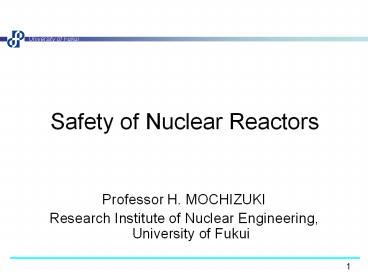Safety of Nuclear Reactors - PowerPoint PPT Presentation
Title:
Safety of Nuclear Reactors
Description:
Safety of Nuclear Reactors Professor H. MOCHIZUKI Research Institute of Nuclear Engineering, University of Fukui Objective of the Experiment Power generation after ... – PowerPoint PPT presentation
Number of Views:387
Avg rating:3.0/5.0
Title: Safety of Nuclear Reactors
1
Safety of Nuclear Reactors
- Professor H. MOCHIZUKI
- Research Institute of Nuclear Engineering,
University of Fukui
2
Accident (1/2)
- Design Basis Accident DBA
- Assumption of simultaneous double ended break
- Installation of Engineered Safety
FeaturesEmergency Core Cooling System
ECCSAccumulated Pressurized Coolant Injection
System APCI Low Pressure Coolant Injection
System LPCI High Pressure Coolant Injection
System HPCI
3
Accident (2/2)
- Computer codes are used to evaluate temperature
behavior of fuel bundle. - Computer codes should be validated.
- Blow-down and ECC injection tests have been
conducted using mock-ups. - RELAP5/mod3 and TRAC code are developed and
validated.
4
ECCS
Turbine
Control Rod Drive
Relief valve
Containment Air Cooling System
Sea water
Feed Water System
Residual Heat Removal System (RHR)
Dump valve
Shield Cooling System
High Pressure Coolant Injection System (HPCI)
Low Pressure Coolant Injection System (LPCI)
(APCI)
Bypass valve
Heavy Water Cooling System
Containment Spray System
Condensate Tank
Reactor Auxiliary Component Cooling Water System
Reactor Core Isolation Cooling System (RCIC)
Reactor Auxiliary Component Cooling Sea-Water
System
Main System Diagram of Fugen
5
Blow-down experiment
6
6MW ATR Safety Experimental Facility
7
Water level behavior after a main steam pipe break
8
Simulated fuel bundle
Local peaking is high for the outer rods due to
the neutronic characteristics
Location of maximum axial peaking
9
Thermocouple positions
10
Cladding temperature measured in a same cross
section of heater bundle
11
Calculation model of pipe break experiment
12
Comparison between experimental result and
simulation
13
Improvement of blow-down analysis by applying
statistical method
Downcomer 100 mm break
Scram
ECCS operation
14
Downcomer 150 mm break
Temperature (?)
Time (sec)
15
Severe accident
16
Heat transfer of melted fuel to material
17
Heat transfer between melted jet and materials
18
Fuel melt experiment using BTF in Canada
19
Fuel melt experiment using CABRI
20
Source term analysis codes
General codes NRC codes ORIGEN-2, MARCH-2, MERGE, CORSOR, TRAP-MELT, CORCON, VANESA, NAUA-4, SPARC, ICEDF
General codes IDCOR codes MAAP, FPRAT, RETAIN
General codes NRC code (2nd Gen.) MELCOR
Precise analysis codes Core melt SCDAP, ELOCA, MELPROG, SIMMER
Precise analysis codes Debris-concrete reaction CORCON
Precise analysis codes Hydrogen burning HECTOR, CSQ Sandia, HMS BURN
Precise analysis codes FP discharge FASTGRASS, VICTORIA
Precise analysis codes FP behavior in heat transport system TRAP-MELT
Precise analysis codes FP discharge during debris-concrete reaction VANESA
Precise analysis codes FP behavior in containment CONTAIN, NAUA, QUICK, MAROS, CORRAL-II
21
CONATIN code
(13)
Air
Containment spray
In case of containment bypass
Containment recirculation system
Air
(14)
(11)
(12)
Annulus
Stack
(10)
(9)
(7)
(8)
Filter Blower
Water flow
(6)
(5)
Gas flow
(4)
(3)
(1)
(2)
Steam release pool
22
Fluid- structure interaction analysis during
hydrogen detonation
23
Analysis of Chernobyl Accident - Investigation
of Root Cause -
24
Schematic of Chernobyl NPP
25
Elevation Plan
26
Above the Core of Ignarina NPP
27
Core and Re-fueling Machine
28
Control Room
29
Configuration of inlet valve
30
Drum Separator
31
Configuration of Fuel Channnel
32
Heat Removal by Moderation
Pressure tube
Graphite ring
Maximum graphite temperature is 720? at rated
power
f91mm
Heat generated in graphite blocks is removed by
coolant
f114mm
f88mm
f111mm
Graphite blocks
Coolant
Gap of 1.5mm
33
RBMK VVER
Finland
Russia
Lithuania
Germany
Ukraine
34
Objective of the Experiment
- Power generation after the reactor scram for
several tens of seconds in order to supply power
to main components. - There is enough amount of vapor in drum
separators to generate electricity. - But they closed the isolation valve.
- They tried to generate power by the inertia of
the turbine system.
35
Report in Dec. 1986
36
Trend of the Reactor Power
Power excursion
Thermal Power (MW)
20-30 of rated power
Scheduled power level for experiment
200MW
30MW
sec min hour day
37
Time Chart Presented by USSR
38
Result in the Past Analysis (1/2)
- T. Wakabayashi, H. Mochizuki, et al., Analysis of
the Chernobyl Reactor Accident (I) Nuclear and
Thermal Hydraulic Characteristics and Follow-up
Calculation of the Accident, J. Atomic Energy
Society of Japan, 28, 12 (1986), pp.1153-1164. - T. Wakabayashi, H. Mochizuki, et al., Analysis of
the Chernobyl Reactor Accident (I) Nuclear and
Thermal Hydraulic Characteristics and Follow-up
Calculation of the Accident, Nuclear Engineering
and Design, 103, (1987), pp.151-164. - Requirement from the Nuclear Safety Committee in
Japan
Recirculation flow rate
Drum pressure
Water level
Feed water
Neutron flux
39
Result in the Past Analysis (2/2)
Power at 48,000 MW
Timing of peak was different. Why???
Power just before the accident was twice as large
as the report. Why???
Power at 200 MW
???
Result of FATRAC code is transferred, and initial
steady calculation was conducted.
40
Possible Trigger of the Accident
- Positive scram due to flaw of scram rods
- Pump cavitation
- Pump coast-down
41
Calculation Model by NETFLOW Code
42
Trigger of the Accident
Positive scram
P.S.W. Chan and A.R. Daster Nuclear Science and
Engineering, 103, 289-293 (1989).
Andriushchenko, N.N. et al., Simulation of
reactivity and neutron fields change, Int. Conf.
of Nuclear Accident and the Future of Energy,
Paris, France, (1991).
43
Trigger of the Accident (cont.)
Scram rod (24rods) inserted by AZ-5 button
1.0
Negative reactivity
5.0
8.0
Graphite block
1.5
Positive reactivity
Graphite displacer
Fuel 23.5m
Water Column
44
Simulation from 11900 to First Peak
Data acquired by SKALA
45
Behavior of Steam Quality
Turbine trip RCP trip
Two-phase
Water
Push AZ-5 button
46
Void Characteristic
Da 2Void fraction increase
Da1 Void fraction increase
47
Nuclear Characteristics
Doppler
Void
48
Peak Power and its Reactivity
49
Relationship between Peak Powerand Peak Positive
Reactivity
50
Just after the Accident
51
Control Room and Corium beneath the Core































